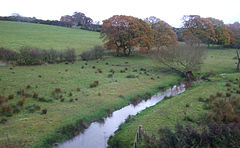Cocklakes
| Cocklakes | |
|---|---|
 Pow Maugham, Cocklakes | |
Location in the City of Carlisle district, Cumbria Location within Cumbria | |
| OS grid reference | NY454510 |
| Civil parish | |
| District | |
| Shire county | |
| Region | |
| Country | England |
| Sovereign state | United Kingdom |
| Post town | CARLISLE |
| Postcode district | CA4 |
| Dialling code | 01228 |
| Police | Cumbria |
| Fire | Cumbria |
| Ambulance | North West |
| UK Parliament | |
Cocklakes is a hamlet in Cumbria, England. British Gypsum formerly had a plant in Cocklakes.[1] It has a lake which is used for fishing.[2] It is served by the A6 road.[3]
Name
The name of Cocklakes originated in Old English with the "Cock-" part of the name coming from the Old English word for "throat" or "ravine".[4] During the Middle Ages, the name was "Cock-Laik", which meant "cockpit" in Middle English.[4] Due to the name, it has been often reported as one of the rudest place names in the United Kingdom, due to cock being a vulgar slang term for penis.[5][6]
Mine
There had been small scale local mining in Cocklakes prior to the 19th century. Around 1830, the first commercial gypsum mining operations started.[7] It was originally owned by John Howe & Co. before being transferred in 1910 to the Carlisle Plaster & Cement Company and later to British Gypsum in 1953.[8][9] Cocklakes mine was also the first place to manufacture plasterboard in the United Kingdom, despite workers initially attempting to separate the paper from the plaster.[7][10] Initially the mine operated on a small scale but due to the Second World War leading to a rise in demand for anhydrite for sulfuric acid. From there, the Cocklakes mine had an underground diesel railway constructed to help with the moving of raw materials.[11]
Following the end of the war, a number of migrant workers from Eastern Europe came to Cumbria to work at Cocklakes mine.[7] The railway changed its locomotives to newer diesel trains in 1970 with their old ones being taken by Carnforth Steam Museum by William Steuart Trimble who would become the High Sheriff of Cumberland.[12] In 1975, the railway was put on care and maintenance.[12]
References
- ^ Industrial minerals. Metal Bulletin. 1981. p. 72. Retrieved 19 July 2012.
- ^ "Fishing marginal water". CW Herald. 28 November 2014. Retrieved 21 March 2020.
- ^ "A6 closed both ways due to 'serious accident'". News and Star. 6 October 2019. Retrieved 21 March 2020.
- ^ a b Sedgefield, W.J. (2018). The Place-names of Cumberland and Westmorland. Manchester University Press. pp. 36, 142. ISBN 9781332027576.
- ^ "Brothers go on epic road trip visiting UK's rudest place names". Gloucester Live. 2 May 2019. Retrieved 22 March 2020.
- ^ "Scots brothers embark on hilarious 'Rude Trip' of filthy UK place names". Daily Record. Retrieved 21 March 2020.
- ^ a b c "Mining Cumbria's gypsum over the centuries". CW Herald. 8 July 2000. Retrieved 21 March 2020.
- ^ Durham Mining Museum (30 April 2019). "Cocklakes (Gypsum)". Durham Mining Museum. Retrieved 21 March 2020.
- ^ "British Gypsum Works, Cocklakes". The National Archives. Retrieved 21 March 2020.
- ^ "Cumbrian gypsum beds stretching from Brough to Barrow". CW herald. 4 June 2005. Retrieved 22 March 2020.
- ^ Edgar, Gordon (2016). "12". Industrial Locomotives & Railways of Cumbria. Amberley Publishing. ISBN 978-1445648347.
- ^ a b Tyler, Ian (2000). Gypsum in Cumbria. Blue Rock. p. 149. ISBN 0952302845.
External links
 Media related to Cocklakes at Wikimedia Commons
Media related to Cocklakes at Wikimedia Commons


